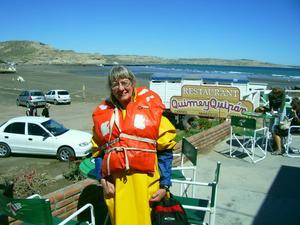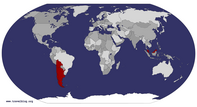Advertisement
Published: January 22nd 2007

 Peninsula Valdes
Peninsula Valdes
Going whale watchingWEEK 2
THE LONG JOURNEY SOUTH
The first section of our 3200K journey to Tierra del Fuego in the far south of Argentina was by overnight train. One of the few rail services left .Our train from Buenos Aires to Bahia Blanca was an experience. We arrived at the station with 45 minutes to spare. We took a numbered ticket (similar to the one in the deli in Sainsburys) No.313 - and they were only at 129. How would 4 desk clerks process 184 passengers in such a short time?-We sat and watched the red numbers gradually increase -zip zip- remarkably fast really. At 250 with 5 minutes to go Carole approached a fat contoller who looked offical. He ushered us to a No. 4 ticket booth on the station concourse and we bought a ticket instantly - but it was ‘tourist class’. No more comfortable pullman class seats were available at that counter!
We boarded the train with minutes to spare. The rolling stock was old. It was like an India train - with shiny brown leather seats, a squat loo and outer doors at the end of each carriage which were never closed but which provided a super view of the passing terrain - unlike the windows which were streaked with dust. Only 6 of the 16 strip lights were working and of those that were, the diffusers were effective fly cemeteries- so full of caracases that they blocked out most of the reflective light. Unlike an Indian train where the floors are always immaculate due to repeated sweeping - the Agentinian train was so dusty that I could write my initials!
Suburban Bueno Aires was experienced from the train. Concrete boxes for houses of the poorer inhabitants adjacent to rubbish filled ditches through constant fly tipping. Occasional belts of linear poplar trees with wild flowers and scrappy burgeonvillia.
On the outskirts of Buenos Aires were horse arenas and jumps and numerous football pitches and athletic training centres on gravelly wasteland with keen would-be international footballers steadfastly training. Occasional floodlight tennis courts for the more well to do. Old grass-covered railway sidings were common - where Beeching like cuts had made the iron giants redundant.
Suburban houses - peeling and unpainted with pantile roofs reflecting colonial Spanish architecture. Numerous sub stations bringing power to the masses and metal electricity poles. Large cement plants providing the for the necessary regeneration, rebuilding and development of the suburbs.
All sat beneath a band of purply -grey polluted haze punctuated by the glare of aircraft lights approaching the big city.
And then it was dark. I was only aware of horizontal horizons and as I glanced into the distance only sombre shades of grey distinguishing land from sky.
Eventually we both found seats to lie out on and we crossed ‘las pampas’ - a horizontal featureless landscape, without a problem.
A rosy sunrise through cracked glass and distant peaked hills beyond the pampas.Vast areas of grey green rough grazing land for cross bred cattle, horses and occasional out door pigs. Extensive pale cream wheat fields and numerous grain silos adjacent to the track - the link from field to port for export to the wider world. Occasional clumps of scraggy poplar trees sheltering corrrugated iron shacks and farm steadings with rotating windmill pumps to raise water for their needs. Very few signs of life or vehicles on the dusty remote roads.
BAHIA BLANCA
Bahia Blanca, 700k south, was a lovely surprise. Still run down and without sparkle - even the Pepsi cola sign was peeling! - but this city of 300,000 was alive and inspiring. We chose a slightly classier hotel to recover from our overnight journey. An old colonial building with dark wood and brass which provided comfortable beds and breakfast buffet with the first scambled eggs so far. An afternoon exploring. A huge plaza with a wide variety of shops reflecting increasing affluence from the growth of the port exporting wheat and the expansion of the petro chemical industry. I found a wonderful carniceria (butcher) selling marinated olives and cheese which was very tasty. The young assistants recognised me on my second visit and were intrigued as to why scotsmen wear ´faldas’ ( skirts!).
Our exploration took us to the old theatre with antique fittings. The faded crimson velvet seats were supported on intricate cast iron legs which were screwed to a sloping wooden floor. The theatre sides had narrow balconies with individual period chairs. It was not unlike the Bolshoi theatre in Moscow. We waited on the steps before the performance where large groups and friends and families gathered. The women warmly kissed and hugged each other and the men kissed and patted each other on the back. The modern ballet production was intriging- a mixture of modern dance by a young dance troop, set to music, video, prose and peotry.
We were caught out on the way home by a violent thunderstorm.(first time out without our brollies.) We sheltered in a bar and watched the water gush along the street like a river. Some time later when the rain had abated we picked our way back through the puddles, Carole tottering along at high speed in her high heels -(brought specially for the tango!)
The next morning we purchased a return bus ticket from a sweetie kiosk to the port in search two museums.
The Port Museum intepreted spanish colonial life in the port by early inhabitants: a reconstructed house, school room and bar in an old colonial wooden building with a verandah.
The Ferrowhite Museum is a wonderful new museum in the old railway workshops which interpreted the role of the British in building the railways to access the hinterland to bring out wheat for export. The steam engines imported from the UK were maintained in huge workshops. Originally fed on coal imported from Cardiff- they were later fired by local timber and then oil.
Coleman and White, two British engineers were responsible for the growth and management of the site in its heyday. Now the large acreage of grass covered sidings is a tribute to the former glory and industrialisation. Today more and more wheat is trsansported to the docks by truck and trailer.
Lunch, and I ordered a milanese which is like a beef schnitzel. Very mediocre. I must rember that medallions or lomo means thick juicy piees of steak!
An enexpected mystery tour evolved in the afternoon as we intended to do a recki of the bus terminal to purchase tickets for the over night bus to Puerto Madryn. Thinking that the local bus would terminate the bus station we missed our stop and tour through suburbam Bahia Blanca began. However obviously travelling for free we feared the arrival of an inspector - but we were lucky and we enjoyed the sights of the suburbs and the locals getting on and off the bus!
IN SEARCH OF THE WHALES
Our over night bus made Megabuse’s new fleet look very mediocre! Plush comfortable reclining air craft seats, leg rests, cutains, video, free sandwiches made the 10 hour journey very acceptable. I have a recollection of the horizontal pampas with small shrubs and rough grass against the moonlight sky. A few birds with forked tails and a couple of small deer against the metal fencing parallelling each side of the road .
The aluminium smelter, huge cement works and brickworks welcomed us to Puerto Madryn. A walk from the bus station along footpaths where each building seemed to be responsible for the tiles and blocks on the footpath. As a result my rucksack on wheels made a variety of clattering sounds as it trundled along. We soon found a small apartment with kitchen and lounge and twin bedded room in the quiet suburbs.
Puerto Madryn is however is growing very quickly due to its proximity to the Reserva Faunistica Peninsula Valdes a World Heritage site. Here two ocean currents meet and the peninsular provides homes and breeding grounds for the rare southern white whales, magellan penguins and elephant seals.
A special day to see the endangered southern right whales. It was from Puerto Pyramides that we sailed alongside the horizontally bedded sandstone cliffs into the bay. It was not long before the whales came. Massive creatures twice the length of a double decker bus and weighing 40 tons! With them were their 2-4 month old calves weighing 4-5 tons at birth, staying close to their mothers and rolling over their backs or suckling 60-70 litres of milk each day. Far from beautiful with limpet like covered heads creating distinctive patterns which aids recognition the whales are truly majestic as they expose the huge mass of their bodies as they swirl and roll through the water. The sight of them spraying water through their blow hole or exposing only their whale tails above sea level is incredible -but so difficult to photograph! What a priviledge to see such wonderful creatures from a distance of 20 metres. Soon they will leave and swim to South Georgia near Antarctica where they will feed on krill and plankton carried north on ocean currents.
WELSH SETTLERS
A short bus journey to Trelew where we stayed in the traditional Touring Club Hotel where we had the best room with a large balcony over looking the main street. ( They always offer the best room first hoping to get the highest price they can! Must remember to ask for a cheaper alternative next time! The learning curve never seems to level out!)
Admist the ‘badlands’ of the Patagonian steppe desert the Rio Chubut flowing east from the Andes has carved a wide valley. This area has been exploited by a group of Welsh settlers since the 1850’s who left to escape supression by the English in order to establish a traditional Welsh community here. In contrast to the surroundings this irrigated valley is lush and green producing a variety a vegetables and fruits which are sheltered from the strong winds by linear poplar shelter belts. Welsh is still spoken and the British Government sponsors a welsh language teacher. However 3 or 4 generation youngsters see themselves as Argentinian and it becoming harder to retain a traditional welsh culture.
At Gaiman we treated ourselves to a traditional Welsh high tea at one of the many tea shops- a specially of the area. The cakes unfortunately were very mediocre but the tea was OK!
Advertisement
Tot: 0.095s; Tpl: 0.013s; cc: 13; qc: 50; dbt: 0.0576s; 1; m:domysql w:travelblog (10.17.0.13); sld: 1;
; mem: 1.1mb









